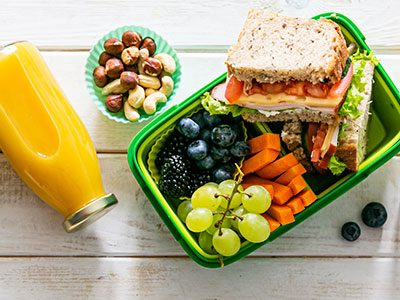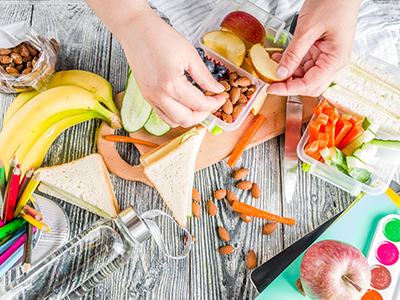About one-third of children and adolescents in the United States are considered overweight or obese. Obesity puts a lot of stress onto a child’s heart. However, health consequences of this epidemic – such as type 2 diabetes, elevated “bad” cholesterol levels (LDL), and high blood pressure – can improve through nutrition.
Introducing a healthy variety of foods to children and involving them in meal preparation is a creative and effective way to enrich the health of kids and families. Many of us have heard that healthy eating and living is not about the latest fad or an unrealistic diet, but a lifestyle change. This is absolutely true! By teaching your children nutritious habits now, you are equipping them for a healthy future as an adolescent and adult. Start that future today by following these simple heart-healthy tips:
Go for the whole grain
Whole grains contain fiber which helps lower LDL cholesterol levels. Choose foods with “whole grain” as the first ingredient on the food label. Oats are high in soluble fiber and while most commonly consumed as oatmeal, they are easily incorporated into smoothies, casseroles, burgers, cookies and other baked goods. Other whole grain options are popcorn, barley, quinoa and brown rice.
Color your plate with fruits and veggies for a healthy heart
Fill half of your plate with fruits and vegetables. The fiber in fruits and vegetables may reduce risk for heart disease. Eating a variety of fruits and vegetables also can protect against certain forms of cancer. This is an exciting food group for kids as there’s an entire rainbow of colors and variety to choose from.
If your child refuses to eat anything that grows out of the ground, don’t feel defeated, it’s normal! It can take multiple occasions offering a new food before a child (and some adults) will even taste it, let alone like it. Offering the fruits and vegetables your family likes alongside new healthy foods may increase diet variety over time.
You can incorporate more fruits and veggies by substituting one snack-sized cup of applesauce for a ½ cup of oil while baking, for example. Or, add spinach in your spaghetti sauce and load up your pizza and sandwiches with greens and pineapple.
Face the (good) fats
Some fats are heart healthy like omega-3 fatty acids and monounsaturated fats, which can lower cholesterol levels. Good sources of omega-3 fats:
- Fatty fish (salmon, lake trout, mackerel and albacore tuna)
- Canola oil
- Walnuts
- Flaxseed – a great addition to yogurt, smoothies and baked goods but must be ground for our bodies to digest the healthy fat.
- Monounsaturated fats are found in nuts, avocados, peanut butter and olive oil. Even healthy fats are still energy dense and should be eaten in moderation providing about 25-35 percent of total energy intake in children and adolescents.
Heart healthy recipe idea – blueberry banana smoothie pops
Use this simple recipe as a fun way to incorporate variety into your family’s diet:
Ingredients:
- 1 cup blueberries (frozen or fresh)
- 1 large ripe banana
- 1 cup fat-free milk (or use almond milk, etc.)
Directions:
- Blend ingredients for 60-90 seconds.
- Pour into molds and freeze overnight.
*You can add a 1-2 tsp. of honey or agave nectar for extra sweetness.
*Try substituting the blueberries for raspberries, strawberries or a fruit of your preference.
*Experiment with this recipe by adding spinach or avocado.
More important than any education dietitians provide is the unique opportunity parents and caregivers have to lead by example at home on a daily basis. Family involvement in nutrition, like growing a garden, shopping and preparing foods or sharing meals together are all components of heart healthy living and they’re fun!
For more detailed information on dietary guidelines for the pediatric population or adults visit www.heart.org or www.choosemyplate.gov.
 https://riseandshine.childrensnational.org/wp-content/uploads/2025/12/Mom-nursing-feature.jpg
300
400
Rise and Shine
https://riseandshine.childrensnational.org/wp-content/uploads/2017/11/childrens_riseandshine_logo.jpg
Rise and Shine2025-12-04 11:29:032025-12-04 11:29:03Tips for surviving your first month of breastfeeding
https://riseandshine.childrensnational.org/wp-content/uploads/2025/12/Mom-nursing-feature.jpg
300
400
Rise and Shine
https://riseandshine.childrensnational.org/wp-content/uploads/2017/11/childrens_riseandshine_logo.jpg
Rise and Shine2025-12-04 11:29:032025-12-04 11:29:03Tips for surviving your first month of breastfeeding


 Jessica McGee, MS, RD, CSP, LD, CNSC, was the Food and Nutrition Services Clinical Nutrition Manager at Children's National.
Jessica McGee, MS, RD, CSP, LD, CNSC, was the Food and Nutrition Services Clinical Nutrition Manager at Children's National.


















Leave a Comment
Want to join the discussion?Feel free to contribute!